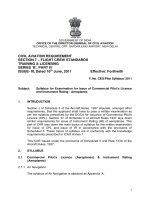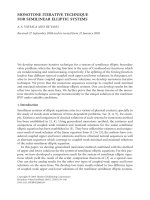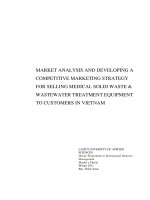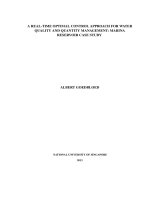RISE TIME: OPERATIONAL CONTROL TESTS FOR WASTEWATER TREATMENT FACILITIES INSTRUCTOR''S MANUAL AND STUDENT WORKBOOK
Bạn đang xem bản rút gọn của tài liệu. Xem và tải ngay bản đầy đủ của tài liệu tại đây (772.4 KB, 21 trang )
,DOCUNENT:NESUME
ED 221 397- SE 039 209
AUTHOW ,Carnegie, John W.
TITLE Rise Time. Operational Control Tests for Wastewater
Treatment Facilities. Instructor's Manual [and]
INSTITUTION Student Workbook.
SPONS AGENCY Linn-Benton Community Coll.,Albany, Oreg.
Office of Water Program Operat*ons (EPA), Cincinnati,-
PUS DATE Ohio. National Training and Operational Technology
GRANT
Center.
'NOTE
)Jul 82
AVAILABLE FROM
EPA-900953010
21p.; Sok related document, see SE 039 212.
Linn-Benton CoMmunity College, 6500 S.W. Pacific
Blvd., Albany, OR 97321 ($1. student work)rok, $2.
instructor's guide).
.:EDRSkRICE MF01 Plus Postage. PC Not Available from EDRS.
DESCRIPTORS Instructional Materials; *Laboratory Procedures; .
Postsecondary Education; *Sludge; Teaching Guides;
IDENTIFIER. *Training Methods; *Waste Water; *Water Treatment
Rise Time Test
^.1
ABSTRACT
The rise time test (along with the settleometer
procedure) is used to monitor sludge behavior in the secOnciall
clarifier of an activated sludge system. The test monitors the effect
of the nitrification/denitrificstinn Process ,and Aida the 0Peratot- in
determining optimum clarifier sludge detentinnttime and, to some
extent, optimum degree of .oxidation in aerition basin. Designed
for individuals who have completed Nation -Pollutant Discharge
Elimination System (NPDES) level 1 laborato training skills, this
module provides waste water treatment plant operators with the basic
skills and information needed to: (1) run and evaluate the test for'
sludge rise time; (2) record data; and (3) describe how
,.nitrification/denitrification affects sludge rise time. The
instructor's manual contains a statement of instructional goals,
lists of instructor/student activities and instructional materials,
and student worksheet (with answers). The student workbook contains
objectives, prerequisite skills Apeded before the module is started,
laboratory procedures, and worksheet. (Author/JN) .
,
* Reproductions supplied by EDRS, are the best that can be made *_-,.
* from the original document. *'
***********************************e************************.***********
eratiOnal ControliTests
r Wastewater Treatment Facilities
A
US. DEPARTMENT OF EDUCATION ,
NATIONAL INSTITUTE OF EDUCATION
I30 EDUCATIONAL RESOURCES. INFORMATION.
CENTER (ERIC).
This document has been wept ocluce'd ori
received Itom .the perSon or nolahltdodo,
omenriturri
MI001 chanheS have beim made to immove
reproduction qiii,11
Points of sloVV:or opinion tete!) m Mrs dorm
Merit dr) not- necessmily
NIEr.
Oositidrvor policy -
"PERMISSION TO REPRODUCE THIS
MATERIAL IN MICROFICHE (ONLY
HAS BEEN GRANTED BY
TO THE EDUCATIZ5NiALAESOURCES
INFORMATION CENTER (ERIC)." ,
Written By:
John W. Carnegie,
Linn-Benton Cothmuhity College
AlbanY,J)regon-,
Instructional Design:
Priscilla Hardin
Corvallis, Oregon
P.roject Management:
John W. Carnegie, Ph.D.,-
linnBentori ComMunity C011ege
Albany, Oregon
Project Officer:
Lynn S. Marshall
United States Environmental Protection Agency
.National Training and Operational Technology Centei-
Cincinnati, Ohio
Developed Under:
EPA Grant #900953010
July, 1982
4 7:Pkge
Rt-1
CONTENTS Rt-1
Subject Rt-2
Instructional Goals Rt-2-,
I:nstructor .Acti4ti.es W7Rt-1
StudentActiylties,..,, S-Rt-1 thru 8
Instructional Materials Litt WS-Rt-1 thru 2
Reference: List
AnsWers tO:Woricshee.t
Student-Materials',
Rt-i 7/62
INSTRUCTIONAL GOALS
Upon completion of this lesson the student %hould be able to successfully
run rise time tests and record the data. The student should also,be able
to describe how.nitrification/denitrification affects sludge rise time.
Use this lesson in conjunction with the.lesson on the settleometer.
INSTRUCTOR ACTIVITY
For best results, follow this sequence:
Activi,tY
Review the objectives with the students. -2 minates
10,minutes
Have the students read through tile, 10 minutes
procedure and supplementary material: 10 minute§
Lecture/discussiOv on procedurelh 5 minutes '
3 minutes
. .
Demonstrate .settleOmeter equipment
(Show selected-slides from settleometer:.,
lesson-if avatlable.)
. Assign worksheet.
6. Correct worksheet.
Other Activities:
1) If sludge samples are available, set .up a settleometer in advance to
demonstrate what a sludge sample looks like after rising.
) If students are capable, discuss chemistry of nitrification/denitrification.
TUDENT ACiIVITIES
1. Read objectives.
2. Read procedure and supplementary material.
3. Listen to lecture/demonstration.
. Complete worksheet.
go-
INSTRUCTIONAL:MATERIALA LIST
I. :Instructor!i Suide for Rise Time.
2. Student -Workbook for Rise-Time.
3. 35 mm projector and screen (if using settleometerslides).
4. Settleometer equipment for demonstration.-
5. SI udge- sampl e:
REFERENCE LIST_
)
u.Wandbdok of Advamced Wastewater Treatm t", .2nd Edition, Culp-, Wesner,
and,CPIP:VONostrand-,Reinhold197S, Chapt
-. .
"Chemistry. fOr Envfronmental .Engineering" , 3rd Edition:,
MCGraw-Hill-: .1978.
Rt-2 of 2 1/82
RISE TIME
WORKSHEET.-
Directions: Place an "X" by the best answer(s).. There may be
more than one correct response.
I. Microorganisms in mixed liquor convert ammonia to nitrite
and then to nitrate by a process called:
a) fermentation.
b) 'denitrification.
c) X nitrification.
d) fertilization.
e) clarification.
Denitrification:
a) 'is\an aerobic process.
b) x is an anaerobic process.
,c). X is a, reduction process.
d) As an oxidation process.
3. Rising sludge in a secondary clarifier:
. a) is always a hydraulilt problem.
b) X could be caused by trapped nitrogen gas.
x. contributes to poOr effluent.
d) means sludge detention time is too short.
7 7/82
r-
W-Rt,1 Of 2
. To run a rise time test:
a) it is best to start over after running the settleOmeter
test.
put settled sludge in a beaker and gently bubble air in
under the blanket;
c) measure the volume of the blanket after it expands.
*
d) X continue observing settled sludge until it rises.
5. The rise time for settled activated sludge:
a) X ,could be as short as one hour.'
b)., X could be as long as six hours.
c) X could be longer than'elht hours.
d)_ is always 3 - 6 hours.
ICS
r 40.
W-R1-2 of. 2 -:7/82
perational Control Tests
for Wastewater Treatment Facilities
Rise Time
Student Workbook
fr
Linn-Benton Community College
Albany, Oregon
RISE TIME
Written By:
John W. Carnegie, Ph.D.
Ling-Benton Community College
Albany, Oregon
Instructional Design:
Priscilla Hardin
Corvallis, Oregon
Project Management:
John W. Carnegie, Ph.D.
Linn-Benton Community College
Albany, Oregon
Project Officer:
Lynn S. Marshall
United States EnviroriNental Protection Agency
National Training and-Operational Techhology Center
Cincinnati,.0hio
Developed Under:
EPA Grant #900953010
July, 1982
10
RISE TIME Page
CONTENTS S-Rt-1
S=Rt-1
Sub'ect
IntroductiOn S4t-1
,Objectives 14t71
PrereqUittte Skills
ResoUrce Litt' S-Rt-2
Test ProCedure
SupplementarY Materials S-Rt-6
Test Data Sheet S-Rt-7
Sample Data Sheet S-Rt-8
Procedure Summary WS-Rt-1
WOrktheet
1
lii 7/82
S-Rt-i
,
NINTRODUCTiON
This lesson on,-rise time is intended to be used in conjunction
with the module, on the settleometer. It is presented separately
'to enphasize the unique value of the test. The lesson is inten-
ded to give the operator the skills to run and ,evaluate the test
for sludge rise time.
OBJECTIVES
Upon completion of tIzis module you should be able t :
1. Describe the,purpose of the rise tirne" test.
.2. Describi"the test procedure.
3. Perform the test procedure.
PREREAUISITE SKILLS
This module is intended to be used by individuals_kdho 'have com-
pleted the NPDES Level I laboratory skills training . In addition,
you should be familiar with the settleometer procedure and the
prerequisite skills listed with th'at module.
RESOURCE LIST
\
Settleometers may be purchased from:
1. Arthur H. Thomas Co. Nalgene Settleometer
and Centrifuge Kit
s Vine Street at 3rd
#9857-V25
P.O. Box 779
Philadelphia, PA 19105
2. 'SGA Scientific, Inc. J S - 1035
Settleometer
735 Broad Street,,
Bloomfield; NJ, 07003 2 liter
Double grad.
a
12. 7/82
S -Rt -1 of 8
INTRODUCTION
The microorganisms in the activated sludge proce s that
help form the flop in !mixed liquor are mostly aerobic a d facul-
tative organisms. Inthe aeration basin where oxygen is plentiful,
they metabolize aerobically. Under certain aerobic cond tions,
ammonia is oxidiied to nitrite and then to nitrate by the microor-
ganisms. This process is called nitrification. When the mixed
liquor enters the secondary clarifier it settles in an oxy en
deficient environment. Under these.anaerobic conditions f cul-
tative microorganisms reduce the nitrate formed earlier to itrite
and then to nitrogenigas. 'This process is called denitrific tfon.
Nitrogen gas S-eleased_during denitrification can become
trapped in the settling floc and cause it to float to the sur ce
degrading effluent quality. Mixed liquor in a settleometer will
also denitrify and eventually the'settled blanket in the settle-
ometer will rise to the top. The time at which this occurs gives
an estimate of nitrification/denitrificatiOn activity and how long
s,ludge can safely be detained in the clarifier.
EQUIPMENT7
Settleometer - 2 liter Mallony Direct Reading SGA Scientific, Inc.
Catalog CS-1035, or Nalgene Catalog #1010.
Stirring paddle
Timer (Electric Gralab, Model 500 or equivalent)
PROCEDURE
1. RUN,SETTLEOMETER TEST.
Refer to the lesson on settleometer
tests. tóllect sample and observe sett-
ling as indicated. Do not discard sample
after observing sett-1111g.
2. CONTINUE TIMING,
Continue timing the settling from the
original zero time far the settleometer
test.
OBSERVE SLUDGE BLANKET.
Watch for the blanket to rise to the
.' surface or flip over and float to the
top.
4 3 S-Rt-2- of 8 7/0? 0
12.2
4. RECORD RISE TIME.
Record rise time on settleometer data
sheet. The rise time may take only
one hour or it ma y. not nise in eight
hours or more. 'Typically, rise times
are 3 - 6 'hours.
DISCARD SAMPLE AND CLEAN SETTLEOMETER.
INTERPRETATION
The,rise time test, along with the normal settleometersprocedure,
is used to monitor,sludge behavior in the secondary clarifier of gh
activated ,sludge system. The rise time test specifically'san monitor
the effect of the nitrification/denitrification process .and,,can aid
the, operator in determining optimum clarifier sludge detention time
and, to some extent, optimum degree of oxidation.in the aeration
basin. .0, 0 -)
Nitrification occurs in the aeration basin:and results in the
formation of nit,,stes in the sludge going to the secondary clarifier.
Nitrification occiirs in all plants to some degree: Any plant having
amonia nitrogen levels of 2.5 mg/1 or higher.in the raw influent can
expect significih nitrification if conditions are appropriate. The
temperature, pH,''and dissolved oxygen level in the aeration basin all
.inMence nitrification. The warmer the activated sludge, the mbre
nitrification,will occur. Optimum pH for nitrification 'is about 8.5.
Twice as,much nitrification can-be expected at a ILO. of' 2.0 mg/1 as
would occur at a D.P. of 0.5 mg/l.
The anaerobic denitrification: process occurs in the clarifier
sludge blanket as the sludgeloses its D.O. and becomes anaerobic.
As the,sludge becomes anaerobic the nitrogen gas released during
denitrification is trapped in the sludge particles causing the sludge
to rise to the top in clumps,and deteriorating effluent ,quality. How
quickly this occurs depends on the D.O. content of the sludge and the
degree of nitrification that took place in the aeration basin.
The rise" time test measures how quickly the sludge can be ex-
pected to rise. Rise times might vary from one hour to six hours.
Some sludges may never rise. Normally oxidized, domestic sewage could'
be expected.to rise in three to four hours.
The operator should calculate the sludge detention time for the A
4.secondary clarifier and compare that to the rise time. If the rise
time is less than the detention time,' rising sludge problems can be
expected. Sludge detention time should be decreased by removing sludge
from the Clarifier faster,. Nitrification Can also be influenced by
'adjusting D.O. in the aeration basin. However, be cautious of upsetting
otherwise'good quality sludge production.
S-Rt-3 of 8 7/8Z
SUPPLEMENTARY MATERIAL
The purpose of the settleometer test is to indicate the
solids-liquid 'separation capability of the sludge. The test
is commonly used to make this determination on activated sludge
entering the secondary clarifier and aerobic digesters, to de-
termine downtime of the sludge.
EQUIPMENT'
Settleometer - 2 liter Mallory Direct Reading S1A Scfentific, Inc.
Catalog #JS-1035, or Nalgene Catalog #1010
Stirring paddle
Timer (Electric Gralab, Model 500 or equivalent)
COLLECT SAMPLE.
Collect at least 2.5 liters of sample and
deliver to ihe lab within 15,minutes. c
After the sample has been collected, it should
be thoroughly but gently mixed and poured into
the settleometer without delay.
POUR SAMPLE INTO SETTLEOMETER.
Fill the settleometer to the 1000 cc mark. Al-
though the settleometer actually holds 2 liters,
it is calibrated from 0 - 1000 cc.
STIR SAMPLE.
Slowly stir the sample in the settleometer with
a paddle to insure that it is completely mixed.
Then, use the paddle to stop the swirling motion
of the liquid, slowly and carefully remove the
paddle and start timing.
Pieces of plexaglass the appropriate length make
excellent stirring-paddles. These pieces should
be slightly less in width than the inside diameter
of the settleometer.
15
S-Rt-4 of 8 . 7/82
READ SETtEOMETER .
For Activated Sludge
After. 5 minutes have elapsed, read the sludge
'Olanket.level, (the interface between the solids
And' the clear liquid above' the solids) in ccil
444nd. recPv144tit$ reading -=.Rea4:1'.at .five-Min4A0
Intervals'-until 30. mfnutes have elapsed:- .01:Wing
the next 30 minutes, read at 10 minute intervals.
Reodings would be made at 5,10, 15, 20, 25, 30.
50, and, 60 minutes. The sludge blanket level
:readings taken at these,iimes are readings of, the'.
volume of settled sludge in cc/1%
RECORD DATA.
Recoed values of data, appearance of supernatant,
apPearance of sludge and of the sludge supernatant
interface.
For Aerobic Digesters
Read and'record the sludje blanket level in cc/l
affer 15 minutes, 30 minutes, and 1 hour, then once
. per hour until the Sludge reaches ultimate compaction
or rises. Determine the time and level of ultimate
compaction, and then the rise time of the sludge.
WASH SETTLEOMETER.
After ,the last r4ading hat beenaken the settle-
ometer shoUld be washed with soapy water, rinsed
with tap water, and dried with a towel or allowed
to drip dry
4§ETTLEOMETER DATA
Activated Sludge a
Observations:
Sample location Floc
Analyst flocculent
Time of Test [ I dispersed
SSC.= (ATC) (1000) Interface
SSV
Time SSV SSC I well defined
cc/1 [ I ragged
0 7 1Q00
10 Supernatant
15 clear
20 [ I turbid
25 [ I pin floc
30 [ I straggler floc
40
50 Comments: (odor, color, etc.)
' Rise Time hrc
Date- Observations:
ample locatiilin Floc
Analyst J flocculent
Time of Test [ I dispersed
SSC + (AT,c) (1000) I nter face
ssv [I well defined
Tinie SSv SSC
cc/1
[
1000,,
SuPernatant
10' [ ) clear
15 [ I turbid
20 4' [ pin floc
25. f I straggler 'floc
30 Comments: (odorc color, ete.)
40
50
Rise TiMe ht-c,
S-Rt-6 of , 1 7 .7/82
SAMPLE DATA SHEET
AERAT4ON BASIN #1
SETTLEOMETER DATA OBSERVE DURING
Activated Sludge FIRST 5 MINUTES
Date SAS Observations:
Sample location 4.60.114, Floc
Analyst .S: 4 . leflecculant
Tire, of Test /61./;"a. f I dispersed
SSC (A.C) (1000) Inter face
SSV
f ewell defined
Time SSV SSC
cc/1 f ) ragged,
1000 Supernatant AFTER 1 'HOUR
f I .clear
5
ft/turbid ,
10 1/00 7.5
15 .125
211 290
25 .200 1.1 pin floc
.30 2..00 ',straggler floc
40 210 Comments: (odor, color, etc.)
50 400
GO 200 Rise Time
Observations:
Date
ample lo on
SETTLED SLUDGE SETTLED SLUDGE TOTAL TIME UNTIL
VOLUME CALCULATION
SLUDGE ROSE
5 red
10
ragged
is
Supernatant
20
25 ( I clear
30
40 f I turbid
50
f I pin floc
GO
I straggler floc
Comments : (odor,lcolor, etc . )
Rise Time____bri.
S-Rt-7 qf 8 '18 7/82
PROCEDURE SUMMARY
PROCEDURE AEROB'IC DIGESTOR
1. Read at 15 and 30
1. Collect 2..5.liters sample
2. Deliver to lab within 15 min. minutes
3. Mix sample 2. Read rise time
4. Pour 3 liters into settleometer Settleometer
5. Stir '
6. Stop Motion of sludge
ACTIVATED SLUDGE
1. Read every 5 minutes for first
30 minutes and every 10 minutes-
for next 30 minutes.
2. Read rise time.
The abOveproceOure summary is designed as a 4poratOY 41(17-.. tt
may be cut out and attached tO a 5" X 7" Wei: card for'convenlight
reference at the laboratory bench. To protect the card you may
wish to cover it, front and back;'With clear, .Self-adhesive shelf
paper er similar izlear material.
1.3
S-Rt-8 of 8 7/82
RISE TIME
WORKSHEET
Directions: Plade an 'T by the-best answer(s). There may be
mtre.than:one correct response.
1. Microorganisms in mixed liquor convert ammonia to nitrite
and then to nitrate by a process called:
a) fenmentation.
b) denitrification.
c) . nitrification.
d) fertilization.
e) clarification.
2. Denitrification:
a) is an aerobic process.
b) is an anaerobic process.
c) is a reduction process.
d) is an oxidation process.
3. Rising sludge in a secondary clarifier:
a) is always a hydraulic problem.
could be caused by trapped nitrogen gas.
c) contributes to poor effluent.
d) rans sludge detention time is too short.
2kJ 7/82
WS-Rt1 of 2









